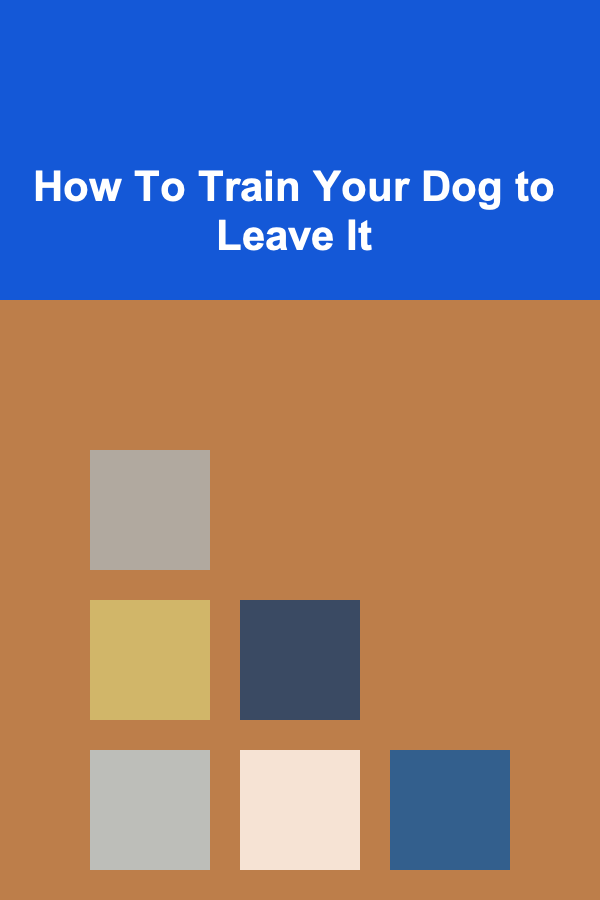
How To Train Your Dog to Leave It
ebook include PDF & Audio bundle (Micro Guide)
$12.99$11.99
Limited Time Offer! Order within the next:

Training your dog to respond to the "leave it" command is one of the most important skills any dog owner can teach. Whether you're trying to keep your dog from eating something harmful, prevent unwanted behaviors, or simply maintain control during walks, the "leave it" command provides a powerful tool to keep your dog safe and well-behaved.
In this comprehensive guide, we will explore how to train your dog to "leave it" in a way that is clear, consistent, and effective. This command can be used in a variety of situations, from keeping your dog away from potentially dangerous items to redirecting them from distractions on walks. By the end of this guide, you'll have a solid understanding of the steps involved and how to apply them effectively to train your dog.
Understanding the Importance of "Leave It"
Before diving into the training methods, it's essential to understand the importance of the "leave it" command. This command helps prevent undesirable behaviors, like eating things off the floor, grabbing items that aren't theirs, or becoming fixated on distractions.
Here are a few key reasons why this command is vital:
- Safety: Dogs are naturally curious and might try to eat or interact with harmful objects, from toxic plants to sharp objects or even food that could upset their stomachs.
- Prevention of Destructive Behavior: A dog that learns "leave it" is less likely to grab things off tables, counters, or the ground.
- Managing Distractions: On walks, your dog might encounter tempting smells or sights. A well-trained dog will respond to "leave it" and focus back on you, preventing potential problems such as running after another dog, car, or animal.
With that in mind, let's move on to the step-by-step process of training your dog to respond to "leave it."
Step 1: Introduce the Command
The first step in training your dog to "leave it" is introducing the command in a calm, controlled environment. This initial stage focuses on teaching your dog to associate the verbal cue with a behavior, so they understand what you're asking of them.
Materials Needed:
- High-value treats (something your dog loves but doesn't get all the time)
- A quiet space free of distractions
How to Introduce "Leave It":
- Get Your Dog's Attention: Start with your dog sitting in front of you. Hold a treat in one hand and let your dog see it. Most dogs will automatically focus on the treat, so you're starting from a place where they are interested and motivated.
- Present the Treat: Slowly present the treat to your dog but do not give it to them. Let them sniff, lick, or try to grab it. Wait for a moment when they back off or lose interest in the treat. The moment your dog pulls back or takes a step away, give them praise and reward with the treat from your other hand (the one not holding the initial treat).
- Say the Command: As you reward them for backing away, say the words "leave it" in a calm, firm voice. Repeat this process several times, reinforcing that the behavior of moving away from the treat results in a positive outcome.
- Gradually Increase the Difficulty: Once your dog is consistently pulling back from the treat and responding to the cue, start presenting the treat on the floor rather than in your hand. Continue to use the command "leave it" as your dog tries to grab the treat.
The goal of this first step is to create an association between the cue "leave it" and the behavior of stepping away from or ignoring the treat.
Step 2: Reinforce the Command with Different Items
Once your dog responds reliably to "leave it" in a controlled setting, it's time to generalize the behavior. This means reinforcing the command with various objects in different environments and situations.
How to Reinforce "Leave It":
- Use Different Items: Begin practicing with different objects---such as toys, food, and household items. Place them in your dog's path and use the "leave it" command whenever they show interest. Reward them when they follow through by ignoring the object.
- Increase Distractions: Gradually introduce mild distractions, such as practicing in your living room with a toy or a treat placed on the floor. As your dog becomes more consistent, increase the difficulty by moving to busier environments like the yard or out on a walk.
- Gradually Remove Rewards: Over time, you can start fading out the treats. Begin rewarding your dog intermittently (not every time). This helps ensure that your dog doesn't rely solely on treats to obey the command.
- Use the Command During Walks: One of the most useful applications of "leave it" is during walks. Dogs are often distracted by scents, other animals, or objects they encounter on walks. To teach your dog to "leave it" in these situations, practice in controlled environments first, then slowly expose your dog to more distractions outdoors.
Step 3: Teach "Leave It" for High-Value Items
High-value items---like food or bones---can present a more difficult challenge for your dog. Dogs naturally have a stronger interest in food and may be more determined to grab it.
How to Train with High-Value Items:
- Introduce the High-Value Item: Begin by holding a high-value treat in your hand (such as chicken or a piece of cheese) and allowing your dog to see it. Let them try to sniff or reach for the treat, but don't allow them to grab it.
- Use the "Leave It" Command: As your dog tries to get the treat, say the "leave it" command. If your dog moves away or shows interest but then looks back at you, immediately reward them with a treat from your other hand. If they don't back off, simply withdraw the treat and wait for them to give up.
- Increase the Challenge: Once your dog consistently responds to "leave it" with lower-value treats, increase the value of the items used in training. Begin practicing with raw food or something even more desirable, like their favorite toy or a chewed-up sock. Repeat the steps above, rewarding them for ignoring the item.
The key here is to build up your dog's tolerance and impulse control around high-value items. This takes patience and consistency, but the result is a dog that can resist even the most tempting things.
Step 4: Practice "Leave It" in Real-Life Situations
The ultimate test of whether your dog has mastered the "leave it" command is to use it in real-world situations. As your dog gets better with the command, you can start practicing it in more dynamic environments, like when they are around food, on walks, or even when interacting with other dogs.
Real-Life Applications:
- During Walks: If your dog attempts to grab something off the ground (like food, trash, or even animal droppings), use the "leave it" command and redirect them to continue walking with you. Reward them for compliance with a treat or praise.
- Around Other Animals: Use "leave it" to prevent your dog from reacting to other animals during walks. This could be helpful in preventing your dog from chasing or becoming overly fixated on other dogs, squirrels, or birds.
- Food and Other Objects: If your dog tries to snatch food from the table or counter, "leave it" can prevent this behavior. It's helpful to practice with food being placed at a distance but within sight to reinforce this in everyday life.
Troubleshooting Common Problems
Training the "leave it" command can take time and patience. Some dogs may take longer to learn the behavior, or they may struggle in certain situations. Here are a few common problems and solutions:
Problem 1: Your Dog Doesn't Listen to the Command
If your dog isn't responding, ensure you're not rushing the process. Start with low-level distractions and work your way up. Gradually add more challenging situations, ensuring your dog feels successful at each stage.
Problem 2: Your Dog Continues to Try to Grab the Object
If your dog is particularly persistent, you may need to revisit the basic stages of training, using lower-value items and reinforcing with consistent praise. Ensure that the rewards are enticing enough to keep your dog engaged.
Problem 3: Your Dog Ignores the Treat You Offer
Some dogs may become fixated on the object they are supposed to leave. In such cases, try using a more motivating or high-value treat to regain their attention. Consistently rewarding the desired behavior will eventually help your dog refocus.
Conclusion
Training your dog to "leave it" is not an overnight process, but with patience and consistency, you can achieve lasting results. The "leave it" command is an essential tool for ensuring the safety and well-being of your dog, while also enhancing your relationship with them through clear communication and positive reinforcement.
Remember that every dog learns at its own pace. The key to success is staying positive, being patient, and gradually increasing the difficulty of your training exercises. With time, your dog will be able to resist temptations, stay safe, and follow commands even in the most distracting situations.

Best Organization Tools for Project Management
Read More
How to Decorate Your Walls for Less
Read More
How to Take Advantage of Employer Stock Purchase Plans
Read More
How To Encourage Positive Behavior with Gentle Discipline
Read More
How to Use AI for Business Intelligence
Read More
How to Start a Smartphone Repair Business: A Comprehensive Guide
Read MoreOther Products

Best Organization Tools for Project Management
Read More
How to Decorate Your Walls for Less
Read More
How to Take Advantage of Employer Stock Purchase Plans
Read More
How To Encourage Positive Behavior with Gentle Discipline
Read More
How to Use AI for Business Intelligence
Read More